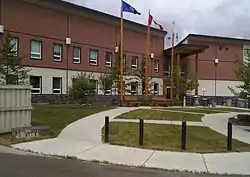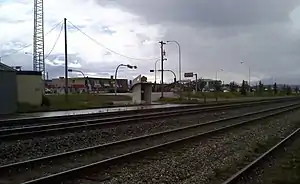Hinton, Alberta
It is located in Yellowhead County, 81 kilometres (50 mi) northeast of Jasper and about 284 kilometres (176 mi) west of Alberta's capital city, Edmonton, at the intersection of Yellowhead and Bighorn Highway, in the Athabasca River valley.
Hinton | |
|---|---|
Town | |
| Town of Hinton | |
 Government Centre | |
 | |
| Motto(s): Gateway to the Rockies | |
 Location in Yellowhead County | |
 Hinton Location of Hinton in Alberta | |
| Coordinates: 53°24′41″N 117°33′50″W | |
| Country | Canada |
| Province | Alberta |
| Planning region | Upper Athabasca |
| Municipal district | Yellowhead County |
| Founded | 1928 |
| Incorporated[1] | |
| • New town | November 1, 1956 |
| • Town | December 29, 1958 |
| Amalgamated[2] | April 1, 1957 |
| Government | |
| • Mayor | Marcel Michaels |
| • Governing body | Hinton Town Council
|
| • Manager | Emily Olsen |
| • MP | Gerald Soroka (Cons - Yellowhead) |
| • MLA | Martin Long (UCP - West Yellowhead) |
| Area (2016)[4] | |
| • Land | 33.52 km2 (12.94 sq mi) |
| Elevation | 990 m (3,250 ft) |
| Population (2016)[4] | |
| • Total | 9,882 |
| • Density | 294.8/km2 (764/sq mi) |
| Time zone | UTC−7 (MST) |
| • Summer (DST) | UTC−6 (MDT) |
| Forward sortation area | T7V |
| Area code(s) | 780 / 587 |
| Highways | |
| Website | www |
Hinton is a town in west-central Alberta, Canada.
Geography
Hinton lies in the Alberta Plateau Benchlands physiographic subdivision of the Interior Plains. Soils around town are influenced by deposits of carbonate-rich, wind-blown sand and silt which usually have surface textures of loam, sandy loam or silt loam. They are moderately alkaline, in contrast to the varying, mostly moderate acidity which prevails beyond the zone of calcareous aeolian material.[6]
History

The Town of Hinton was named for William P. Hinton, Vice President and General Manager of the Grand Trunk Pacific Railway. The community was named in 1911 and remained a hamlet for the next 45 years.
Settlement in the area was scattered along a line some twelve kilometres (7.5 mi) in length. A site along Hardisty Creek, is where an aboriginal group from the Jasper area had left members stricken with smallpox while the rest of the group travelled to Lac Ste. Anne to find medical aid for the smallpox epidemic which was ravaging the indigenous population in Alberta. The area was thus dubbed Cache Picote (Smallpox Camp) in 1870.
In 1888, Jack Gregg established a trading post at Prairie Creek to serve travellers along the Jasper trail. The creek is now known as Muskuta Creek after an incorrect interpretation of the Cree name by white settlers. The construction of the Grand Trunk Pacific Railway saw the establishment of a construction camp at the mouth of Prairie Creek (at the Athabasca River) in 1908. A trestle was built over the creek and is still in use by CN today.
In 1911 the Grand Trunk Pacific built a station house at mile 978 west of Winnipeg. The station was named Hinton, and the community was born.
The Canadian Northern Railway also established a station called Bliss in 1914. The Canadian Northern Railway ran north of the Grand Trunk Pacific line and the Bliss station was located about 4 miles east of Hinton in the Athabasca River valley. In 1916 when the Grand Trunk Pacific rail line was temporarily closed, Dalehurst became the postal station for Hinton. Entrance (formerly Dyke), another important centre to Hinton, served as its communications centre. The original community known as Entrance was so named due to its location at the entrance to Jasper National Park and was located on the Canadian Northern rail line north of the Athabasca River from where Entrance (formerly Dyke) is located. The original site of Entrance is now known as Old Entrance.

The Canadian National Railway became the owner of both rail lines, the Canadian Northern and the Grand Trunk pacific and various portions of both lines were used by the new parent company. The company, however, abandoned the use of the rail line through Bliss in 1926 and once again the rail line through Hinton was opened.
The population of Hinton experienced a boom during the 1930s when American entrepreneur Frank Seabolt and two partners opened the Hinton coal mine in 1931.[7] Shortly thereafter, a recession caused the population to dwindle to fewer than 100 people, but the town began to rebound in 1955 with the construction of a pulp mill. The mill brought rapid growth to Hinton and a new village was developed and was named the Village of Drinnan in 1956. The two communities amalgamated on April 1, 1957, to form the present Town of Hinton.[2]
Hinton train collision
On February 8, 1986 a collision between a Canadian National Railway freight train and a Via Rail passenger train called the Super Continental occurred killing twenty-three people. It was the deadliest rail disaster in Canada at this time, since the Dugald accident of 1947 which had thirty-one fatalities, and would not be surpassed until the Lac-Mégantic rail disaster in 2013 which resulted in forty-seven fatalities. It was surmised that the accident was a result of the crew of the freight train becoming incapacitated, and the resulting investigations revealed serious flaws in Canadian National Railway's employee practices.[8]
Demographics
In the 2016 Census of Population conducted by Statistics Canada, the Town of Hinton recorded a population of 9,882 living in 3,930 of its 4,343 total private dwellings, a 2.5% change from its 2011 population of 9,640. With a land area of 33.52 km2 (12.94 sq mi), it had a population density of 294.8/km2 (763.6/sq mi) in 2016.[4]
In the 2011 Census, the Town of Hinton had a population of 9,640 living in 3,781 of its 4,143 total dwellings, a -1% change from its 2006 population of 9,738. With a land area of 33.77 km2 (13.04 sq mi), it had a population density of 285.5/km2 (739.3/sq mi) in 2011.[9]
The population of the Town of Hinton according to its 2009 municipal census is 9,825.[10] The census originally counted 9,812 people within the town limits[11] but an additional 13 were added when a long-standing annexation application was approved shortly after the census was conducted.
Arts and culture
Hinton is also home to the Wild Mountain Music Fest, a weekend long show hosted by the Entrance Ranch.
Attractions
Hinton is one of two staging areas for expeditions in the Willmore Wilderness Park, the other being Grande Cache.
Nature lovers are drawn to Hinton to visit the Beaver Boardwalk, a 3 kilometre walk where they can see beavers and other wildlife.[12]
Infrastructure

Transportation
Hinton Transit is the municipal public transportation service, operated under contract by First Canada, which is responsible for providing the vehicles, drivers and maintenance. The bus service operates on Monday to Friday from 7:00am to 8:00pm and on Saturday from 8:00am to 7:00pm. No service is provided on Sunday or statutory holidays.
As a flag stop Via Rail's The Canadian calls at the Hinton CN railway station three times per week, in each direction.
Health care
Emergency and other medical care is provided at the Hinton Healthcare Centre.
Education
- Post Secondary
- Yellowhead Regional Educational Consortium (YREC) - Grande Prairie Regional College [13]
- Grande Yellowhead Regional Division No. 35
- Crescent Valley Elementary School (K-7)
- Harry Collinge High School (8-12 English, French)
- Mountain View Elementary School (K-7 English, French)
- Evergreen Catholic Separate Regional Division No. 2
Media
- Newspapers
One weekly newspaper is produced in Hinton; the Hinton Voice, a weekly independent newspaper that started up in June 2009.
- Radio
|
|
Notable people
- Bob Nystrom (born 1952), Swedish-Canadian professional ice hockey player
- Dave Scatchard (born 1976), professional National Hockey League ice hockey player
- Glenn Taylor (born 1961/62), leader of the Alberta Party, former mayor
References
- "Location and History Profile: Town of Hinton" (PDF). Alberta Municipal Affairs. June 17, 2016. p. 330. Retrieved June 19, 2016.
- Province of Alberta (1957-03-27). "Order in Council (O.C.) 494-57, New Town Established (Amalgamation of Hinton and Drinnan)" (PDF). Retrieved April 23, 2010.
- "Municipal Officials Search". Alberta Municipal Affairs. September 22, 2017. Retrieved September 25, 2017.
- "Population and dwelling counts, for Canada, provinces and territories, and census subdivisions (municipalities), 2016 and 2011 censuses – 100% data (Alberta)". Statistics Canada. February 8, 2017. Retrieved February 8, 2017.
- "Alberta Private Sewage Systems 2009 Standard of Practice Handbook: Appendix A.3 Alberta Design Data (A.3.A. Alberta Climate Design Data by Town)" (PDF) (PDF). Safety Codes Council. January 2012. pp. 212–215 (PDF pages 226–229). Retrieved October 8, 2013.
- http://www.agric.gov.ab.ca/soil/survey-reports/ab31/ab31_report.pdf Dumanski, Macyk, Veauvy and Lindsay, 1972. Soil Survey and Land Evaluation of the Hinton-Edson Area, Alberta
- "A History of Hinton". Archived from the original on 2004-02-11. Retrieved 2004-01-10.
- "Hinton Train Collision". Town of Hinton. Retrieved 2011-01-29.
- "Population and dwelling counts, for Canada, provinces and territories, and census subdivisions (municipalities), 2011 and 2006 censuses (Alberta)". Statistics Canada. 2012-02-08. Retrieved 2012-02-08.
- Alberta Municipal Affairs (2009-09-15). "Alberta 2009 Official Population List" (PDF). Retrieved 2010-09-14.
- "Hinton's Population is Up!" (PDF). Town of Hinton. 2009-07-25. Retrieved 2009-08-26.
- http://www.hinton.ca/index.aspx?NID=428
- "About GPRC Regional Learning Centres | Grande Prairie Regional College (GPRC)". www.gprc.ab.ca. Retrieved 2016-06-13.
External links
![]() Media related to Hinton, Alberta at Wikimedia Commons
Media related to Hinton, Alberta at Wikimedia Commons
![]() Hinton travel guide from Wikivoyage
Hinton travel guide from Wikivoyage
